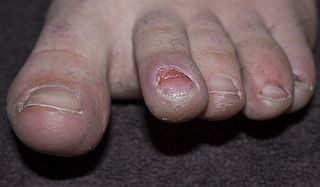Enhance your health with free online physiotherapy exercise lessons and videos about various disease and health condition
Turf Toe
What is Turf Toe
A sprain to the first metatarsophalangeal(MTP) joint , otherwise known as a 'Turf Toe' or 'death toe' , is a common injury in athletes in which the plantar capsule and the ligament of first metatarsophalangeal joint is damaged.
The first MTP joint ROM is variable. The neutral position is described by 0 (or 180) degrees angulation between a line through the first metatarsal and the line through the hallux. Dorsiflexion , the ROM above the neutral position, varies between 60-100 degree. Plantar flexion, the ROM below the neutral position, varies between 10-40 degrees. The ROM is non crepitant and pain free in the uninjured joint.
Anatomy related to turf toe

The power to move the MTP joint is provided by both intrinsic (flexor hallucis brevis, extensor hallucis brevis, abductor hallucis, adductor hallucis) and extrinsic (Flexor hallucis longus, extensor hallucis longus) muscle groups. Two sesamoid bones (medial, or tibial, sesamoid and lateral, or fibular, sesamoid) provide mechanical advantage to the intrinsic plantar flexors by increasing the distance between the empirical centre of joint rotation and the respective tendons. The sesamoid complex articulates with facets on the plantar aspect of the first metatarsal head and is stabilized by a plantar capsule (plantar plate) as well as a ridge (or crista) on the metatarsal head that separates the two sesamoids.
Cause
The classic mechanism of injury is that of a forced hyper extension to the first metatarsophalangeal(MTP) joint, although occasionally a plantar flexion injury may result in this injury. The typical football associated injury occurs when a player firmly plants his forefoot and is then struck from behind. The continued forward motion of the leg over the fixed forefoot produces hyper dorsiflexion of the first MTP joint and increased on the plantar plate and capsule. Taken to an extreme, these forces may continue and produce a dorsal impaction injury to the cartilage and bone of the metatarsal head.
Predisposing risk factor for Turf Toe include-
Classification of metatarsophalangeal joint sprain (Turf Toe)
Grade I-
- Objective findings-No ecchymosis. Minimal or no swelling. Local plantar or medial tenderness.
- Pathologic condition-Stretching of capsulo-ligamentous complex.
- Treatment-Ice/elevation. NSAIDs. Rigid insole. Continued participation in sports.
- Return to sports-Immediately.
- Grade II-
- Objective findings-Ecchymosis. Minimal swelling. Diffuse tenderness. Pain, restriction of motion.
- Pathologic condition-Partial tear of capsulo-ligamentous complex.
- Treatment-Same as Grade I. Restriction of athletic activity for 7-145 days.
- Return to sports-1-14 days.
- Grade III-
- Objective findings-Considerable ecchymosis and swelling. Severe tenderness on palpation. Marked restriction of motion.
- Pathologic condition-Tear of capsulo-ligamentous complex. Compression injury of articular surface.
- Treatment-Same as Grade II. Crutches and limited weight-bearing. If MTP dislocated, reduction and immobilization initially with case. Restriction of athletic activity.
- Return to sports-3-6 weeks.
Clinical Features
The athlete suffering from Turf Toe usually complains of localized pain, swelling, and occasional redness at the 1st MTP joint following a bending injury to the joint. The pain is classically aggravated by weight bearing or movement of the big toe. An antalgic gait may be present as a tendency to avoid loading of the first ray by foot supination.
Examination reveals- Localized swelling and tenderness at 1st MTP joint. In mild injuries plantar and plantar medial tenderness is present; in more severe injuries dorsal tenderness occurs. Passive plantar flexion or dorsiflexion of 1st MTP joint are generally painful, and there may be reduction in range of motion in both direction.
Investigations
Plain X-rays are generally unremarkable, although occasionally small periarticular flecks of bone are noted, most likely indicating avulsion of MTP capsule or ligamentous complex. Isotopic bone scans, although not generally performed, may demonstrate increased uptake in spite of normal X-rays.
Treatment of Turf Toe
Treatment of 1st MTP joint sprain (Turf Toe) is symptom based.
For low-grade Injuries that do not involve significant capsular tears, the patient is instructed to perform gentle ROM. Motion is limited during athletic activity by taping or shoe modification.
For moderate and severe Injuries , including severe capsular tears and dorsal articular fractures, the initial treatment is modified by a brief period of casting with a solid walking cast, or alternatively, a removable walking boot. Once the pain and swelling subsides, attention is focused on re-establishing ROM. Activity is resumed once pain-free ROM is established.
Acute Injuries are treated with RICE (rest, ice, compression, elevation) method followed by a gentle ROM program and protected weight bearing.
Chronic Injuries are treated with a ROM program and protected weight bearing. The hallux MTP joint is supported by a variety of methods including walking cast, removable walking cast, rigid shoe modifications, rigid shoe inserts, stiff soled shoes and a various taping methods. The joint is protected by reducing activity levels, increasing rest intervals and duration, and avoiding rigid playing surfaces. Intra-articular steroids are of no benefit and may be detrimental to the joint.
Operative treatment is rare for isolated 1st MTP joint sprains. Occasionally, an associated condition is recognized and surgery becomes a treatment option.
Prevention of Turf Toe includes the use of supportive footwear (with avoidance of overly flexible shoe forefoot) and firm inserts and avoidance of hard playing surfaces when possible.
Physiotherapy Rehab Protocol For Turf Toe-
- Stage 1: Acute Stage- Day 0 to 5
- Rest, ice bath, contrast bath, whirlpool, and ultrasound for pain, inflammation, and joint stiffness.
- Joint mobilization, followed by gentle, passive and active ROM.
- Isometrics around the MTP joint as pain allows.
- Cross-training activities, such as water activities and cycling, for aerobic fitness.
- Protective taping and shoe modifications for continued weight bearing activities.
Stage 2: Subacute Stage- Weeks 1-6
Read more about Death Toe on Web MD
Stage 3: Chronic Stage- Week 7
Return from Turf Toe to sports physical therapy
Return from Turf Toe to home page
Recent Articles
|
Author's Pick
Rating: 4.4 Votes: 252 |

